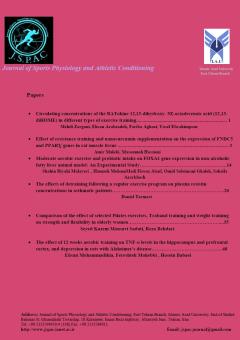-
-
List of Articles
-
Open Access Article
1 - Circulating concentrations of the BATokine 12,13-dihydroxy- 9Z-octadecenoic acid (12,13-diHOME) in different types of exercise training
Mehdi Zargani Ehsan Arabzadeh Fariba Aghaei Yosef Ebrahimpour -
Open Access Article
2 - Effect of resistance training and nanocurcumin supplementation on the expression of FNDC5 and PPARƔ genes in rat muscle tissue
Amir Maleki Masoumeh Hosseini -
Open Access Article
3 - Moderate aerobic exercise and probiotic intake on FOXA1 gene expression in non-alcoholic fatty liver animal model: An Experimental Study
Shahin Riyahi Malayeri Hamzeh MohamMadi Firooz Abad Omid Soleimani Ghaleh Soheila Azarkhosh -
Open Access Article
4 - The effects of detraining following a regular exercise program on plasma resistin concentrations in asthmatic patients
Daniel Tarmast -
Open Access Article
5 - Comparison of the effect of selected Pilates exercises, Traband training and weight training on strength and flexibility in elderly women
Seyed Kazem Mousavi Sadati Reza Behdari -
Open Access Article
6 - The effect of 12 weeks aerobic training on TNF-α levels in the hippocampus and prefrontal cortex, and depression in rats with Alzheimer's disease
Ehsan Mohammadikia Fereshteh Mohebbi Hossein Babaei
-
The rights to this website are owned by the Raimag Press Management System.
Copyright © 2017-2025







